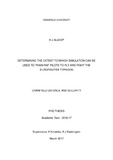JavaScript is disabled for your browser. Some features of this site may not work without it.
| dc.contributor.advisor | Knowles, Kevin | |
| dc.contributor.advisor | Saddington, A. J. | |
| dc.contributor.author | Allsop, A J | |
| dc.date.accessioned | 2017-06-19T14:15:17Z | |
| dc.date.available | 2017-06-19T14:15:17Z | |
| dc.date.issued | 2017-06-19 | |
| dc.identifier.uri | https://dspace.lib.cranfield.ac.uk/handle/1826/12046 | |
| dc.description.abstract | This research examines the extent to which simulation can be used to train pilots of the Royal Air Force to fly and fight the Eurofighter Typhoon, and is the culmination of a series of trials over a period of 4 years. The approach was threefold, firstly examining the performance of students trained entirely on the Operational Conversion Unit’s full syllabus in the simulator and then tested against their peers on each of the four phases in live flight, secondly investigating the cultural acceptance levels of the present Typhoon pilots and lastly using lessons learnt to generate and test a syllabus to train Typhoon pilots to Mult Role Combat Ready in 40% of the present time. It was found that increasing the proportion of synthetics from the lowest Live Synthetic Balance (LSB) of 75:25 used on the front-line meets a cultural and resource barrier at 50:50. This did not represent the maximum LSB achievable however with the heavily synthetic Multi-Role Syllabus reaching an LSB of 21:79 with successful completion of the end of course test. Cultural acceptance of the simulator had correlations with the squadron a pilot was assigned to, the manner in which the simulators were programmed for use and the experience level of the pilot. No evidence was found within the sample to suggest age had an effect. Recommendations on minimum proportions of live and synthetic training was mapped for each of the required tasks and comparisons of these were made across complexity levels. Resource savings found by the generating and testing a Multi Role Combat Ready syllabus that recognised and incorporated all the strengths, weaknesses and lessons identified in the previous trials generated a saving of approximately 9 months and 100 Typhoon live flying hours per student, equivalent to approximately 1300 man maintenance hours that could be reinvested into personnel in the form of leave, adventurous training or development. | en_UK |
| dc.language.iso | en | en_UK |
| dc.rights | © Cranfield University, 2015. All rights reserved. No part of this publication may be reproduced without the written permission of the copyright holder. | en_UK |
| dc.title | Determining the extent to which simulation can be used to train RAF pilots to fly and fight the Eurofighter Typhoon | en_UK |
| dc.type | Thesis or dissertation | en_UK |
| dc.type.qualificationlevel | Doctoral | en_UK |
| dc.type.qualificationname | PhD | en_UK |
